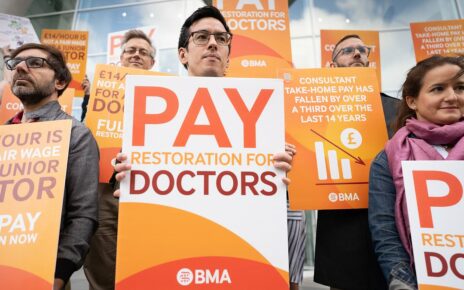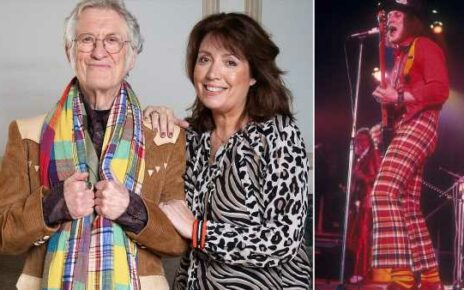When the Queen died, republicans foretold the monarchy’s demise. But Charles’s first year as King has reinforced Royalty’s granite sense of permanence, writes her biographer ROBERT HARDMAN
Amid all the usual froth and fury, Twitter did manage to throw up one decent observation during that historic week this time last year. ‘There’s a pint of milk in my fridge,’ ran a much-repeated meme. ‘It has seen two monarchs and two prime ministers – and it’s still going strong.’
This not only had the merit of being true, given the appointment of Liz Truss as PM on September 6 and the death of Queen Elizabeth II on September 8. It also seemed a thoroughly British response to what might become a very grave crisis.
For in most of the world, the idea of a country losing both a head of state and a head of government in the space of three days would be a recipe for serious civil disorder, if not civil war.
It can happen to the most advanced democracies. Witness the mayhem in the U.S. (where the two roles are merged) when it was time for Donald Trump to leave office and his henchmen laid siege to Capitol Hill in January 2021. Many organisations are at their most vulnerable when there is sudden transition at the top.
In Britain, however, no shots were fired, no mobs took to the streets. There was barely a cross word. Why such a seamless transition? It was, I believe, because of something we either mock or take for granted: the inherent stability and continuity that come with having a constitutional monarchy.
Charles’s first year as King has reinforced royalty’s granite sense of permanence. Pictured: Camilla and Charles on the day of his Coronation
A royal expert said Charles’s Coronation photo showed the sovereign as a ‘monarch who knows his own mind’
In his post-Coronation ‘team’ photo, who should be immediately to the King’s right but the one other person in the family who has been performing royal duties for as long as he has: his sister
The Government had been inert all through the summer of 2022 and the political situation febrile and angry as ever that week. Yet it all seemed of secondary importance on September 8. The big question was: would the nation rally round its new King? And it did.
That was in no small part because Charles III hit the ground running. No one at the Palace needed any reminding of the perils of an absent monarch. The memory of 1997, when the Queen remained at Balmoral after the death of Diana, Princess of Wales, still lingers. Although she did so with the best of motives, namely to throw a ring of compassion and normality around Diana’s sons, a vociferous section of the public and the Press demanded that she should be with her people.
As the days went on, so tempers rose – only for a complete change of public mood once the Queen and Prince Philip finally reappeared in the capital on the eve of Diana’s funeral. After stopping their car outside the Palace to look at the great expanse of flowers and candles, they heard the first indicator that the tide was turning: warm applause.
That is why, less than 24 hours after the death of Elizabeth II, the new King and Queen Camilla were on their way from Balmoral to London. They, too, stopped their car outside the Palace to meet the grieving crowds. I was in the thick of it that day and the response was not just one of deep sympathy – but also appreciation. In addition to seeing a son mourning his mother, here was the Sovereign leading his people.
Their first year in charge hardly enjoyed a ‘honeymoon’ period. Within weeks, the sniping from Montecito started as the Sussexes embarked on a protracted grumble about the awfulness of Britain, its Press and its first family
People forget that the King has been on the receiving end of protests and placards since his student days. The shouters move on. He does not
With dusk falling, the King made that historic address to the nation on television, solemnly pledging himself to his people, ‘as the Queen herself did with such unswerving devotion’ and sending her on her ‘last great journey to join my dear late papa’. A passionate champion of Shakespeare, he concluded with words from Hamlet: ‘May ‘flights of angels sing thee to thy rest.’ ‘ That he had well and truly nailed it was confirmed three days later by a YouGov poll on public reactions to the broadcast. It showed that an astonishing 94 per cent thought it had been a ‘very good’ or ‘good’ speech. You don’t normally see figures like that outside North Korea or Russia.
READ MORE: ‘We recall with great affection her long life, devoted service and all she meant to so many of us’: King Charles’s moving tribute to the Queen as he marks the anniversary of her death at Balmoral – and releases a never-before-seen portrait of Her Majesty
For the death of the longest-reigning sovereign in British history had not illustrated the fragility of the monarchy, as many commentators – especially republican ones – had foretold. Rather, it was a reminder of royalty’s granite sense of permanence. How could this be? After all, we live in a fractious, secular 21st-century state, one entirely different from the social and cultural landscape which greeted the late Queen at the start of her reign. By common consent, she was an impossible act to follow.
I believe that it is down to a combination of factors, some beyond royal control but others which are down to the King.
Take that remarkable Accession Council two days after the Queen’s death. This is when the Privy Council meet at St James’s Palace to agree the proclamation of the death of one monarch and the accession of another. On this occasion, so many Privy Counsellors wanted to be present that their numbers had to be restricted to 200. (Many had been very miffed not to get a ticket.)
It had never previously been filmed, let alone screened live on television, so here was an indication of the greater degree of transparency we could expect under the new King.
In the event, it was not an unmitigated success from his point of view. Social media was soon buzzing with excitement after the cameras picked up the King’s obvious irritation at what would be the first of several problems with royal signatures during those days. In this instance, there was too much clutter clogging the tiny desk on which he was supposed to sign these essential constitutional documents – and his facial expressions said it all.
However, the really striking thing was the contrast between the King and his Privy Counsellors. Here were the most eminent figures in the land – prime ministers past and present, archbishops, generals, the quintessential ‘great and good’.
The death of the longest-reigning sovereign in British history had not illustrated the fragility of the monarchy, as many commentators – especially republican ones – had foretold. Rather, it was a reminder of royalty’s granite sense of permanence
Yet, as the cameras panned around the room, who could claim the longest and deepest experience of public life? Who had been meeting statesmen and making televised speeches since before Liz Truss was born? The King himself. No one else present could point to more than 50 years of unbroken engagement with national and international affairs.
The Queen might have met and known 14 U.S. presidents but Charles III has met ten of them (his first visit to the White House was as a guest of Richard Nixon). No one else in that room could claim to have known de Gaulle, Churchill and Reagan.
Suddenly, the aura had changed. If the nation had tended to regard Charles as a frustrated activist in his princely days, he suddenly felt and looked properly regal. During that initial whistlestop tour of the home nations, it was the King who looked like the old pro while Liz Truss resembled the apprentice on day one of the new job. He wasted no time in getting on with it, either. While the late Queen’s reign began with months of court mourning, this time it would last for a week.
‘He likes having a lot on his plate,’ says one old Palace hand, pointing to the King’s capacity to hit the road all day and then stay up digesting briefs or writing letters. It also means that, at the age of 74 and 76 respectively, the King and Queen Camilla are as busy as ever.
Their first year in charge hardly enjoyed a ‘honeymoon’ period. Within weeks, the sniping from Montecito started as the Sussexes embarked on a protracted grumble about the awfulness of Britain, its Press and its first family. Frequently, on his travels, the King would be greeted by banners saying ‘Not My King’, organised by the pressure group Republic.
Although the protesters would be tiny in number in comparison to the crowds waiting to greet him at the same engagements, the shouters would always gather disproportionate publicity. The King’s response, whether in the wake of a new Sussex bombshell or another shrill demo, has been simply to get on with the job cheerfully without reacting, let alone commenting.
Prince William, Princess Catherine, Princess Charlotte and Prince Louis on the day of King Charles’s Coronation
The noisiest protest was on the day he received the Honours of Scotland at a ceremony billed (wrongly) as his ‘Scottish Coronation’. The Scottish authorities had given the republican posse a prime demonstrating position right opposite St Giles’ Cathedral, which meant that we could hear some of the chanting from our seats inside.
Some royalists and church elders were appalled but the King and Queen were unfazed. Since then, the protests, like the Sussex broadsides, have gradually been losing their novelty value and newsworthiness. Monarchy has always been about playing the long game.
People forget that the King has been on the receiving end of protests and placards since his student days. The shouters move on. He does not. This time a year ago, his detractors were confident that King Charles would be a threat to himself. As an imperious Guardian commentator wrote of the King just days after the funeral of Elizabeth II: ‘A fickle mixture of diffidence and entitlement, he offers hope to the republican cause because he is much more likely to voice his opinion than his mother, who believed that monarchs, like Victorian children, should be seen but not heard.’
That has turned out to be wishful thinking by anti-royalists. They had overlooked the fact that a man who had spent longer as heir to the throne than anyone in history might have given the matter quite considerable thought, hence the absence of those opinions.
As he had acknowledged in occasional interviews (one of them with me), he understood the boundaries which would be imposed on accession. However, he would still retain his ‘convening power’ – his capacity to bring people together and let them dole out the opinions.
We have seen it many times over the past year. Little more than a month after his Coronation, he was hosting one of his new-style receptions at Buckingham Palace, this time in honour of an initiative called the Astra Carta.
READ MORE: What will happen on the anniversary of the Queen’s death? Will there be any official Royal events on Accession Day?
The King’s views on protecting the planet are so well known, he hardly needs to repeat them. But this was about extending the same principles into space, in response to the quantity of space debris and human rubbish floating in orbit.
There was no long speech, as there might have been in pre-Throne days, just a few words of welcome. Yet the point was clear enough as the King expressed the hope that ‘we can ensure the protection of outer space – having made rather a mess of this planet’. There was no question of crossing any constitutional lines.
Friends have noticed a renewed confidence in the King. This is bolstered by the fact that he no longer has to worry about stepping on his mother’s toes but also by the good-humoured, mustn’t-grumble enthusiasm of Queen Camilla. ‘He is delighted by the way she has stepped into the role – and very proud, too,’ says one close friend.
He has also been helped by external events. In turbulent times, people find reassurance in solid institutions which have stood the test of time. As the core team of ‘working royals’ go on their away days and walkabouts around the country, they may not be making headline news. They may not reflect the gloss and glamour of life chez Sussex. But it all makes a connection at a regional and local level.
Nor are these things just about ribbon-cutting and plaque-unveilng. Every engagement is planned to ensure interaction with parts of the country and sections of society which might not normally receive a royal visit but which deserve to be recognised by the State. The Prince and Princess of Wales, the Duke and Duchess of Edinburgh and the Princess Royal all have their own patronages and special interests but their primary objective is to work ‘in support of the King’.
It was, perhaps, no coincidence that in his post-Coronation ‘team’ photo, who should be immediately to the King’s right but the one other person in the family who has been performing royal duties for as long as he has: his sister.
The monarchy has many big challenges – not least a growing republican clamour in some of the King’s 14 other realms and the uncertain futures of the Dukes of York and Sussex. However, it has some important factors working in its favour, too. It all goes back to that sense of permanence.
The public find it a lot easier to accept chaos and infighting at Westminster and the hurly-burly of political life, safe in the knowledge that the core pillars of the nation state – the judiciary, the Armed Forces, the civil service and so on – do not owe their allegiance to any politician. They are loyal to the Crown, not to a Putin or a Macron or an Erdogan.
Even The New York Times grudgingly agreed recently, lately, noting that monarchy ‘meant Britain avoided the perils of presidentialism, which many political scientists now regard as a particularly unstable form of democracy’.
It’s why, in times of trouble, we can still make jokes about the milk in the fridge, rather than bolting the door and listening out for the sound of gunfire.
- Robert Hardman is author of Queen Of Our Times: The Life Of Elizabeth II (Arrow).
Source: Read Full Article









